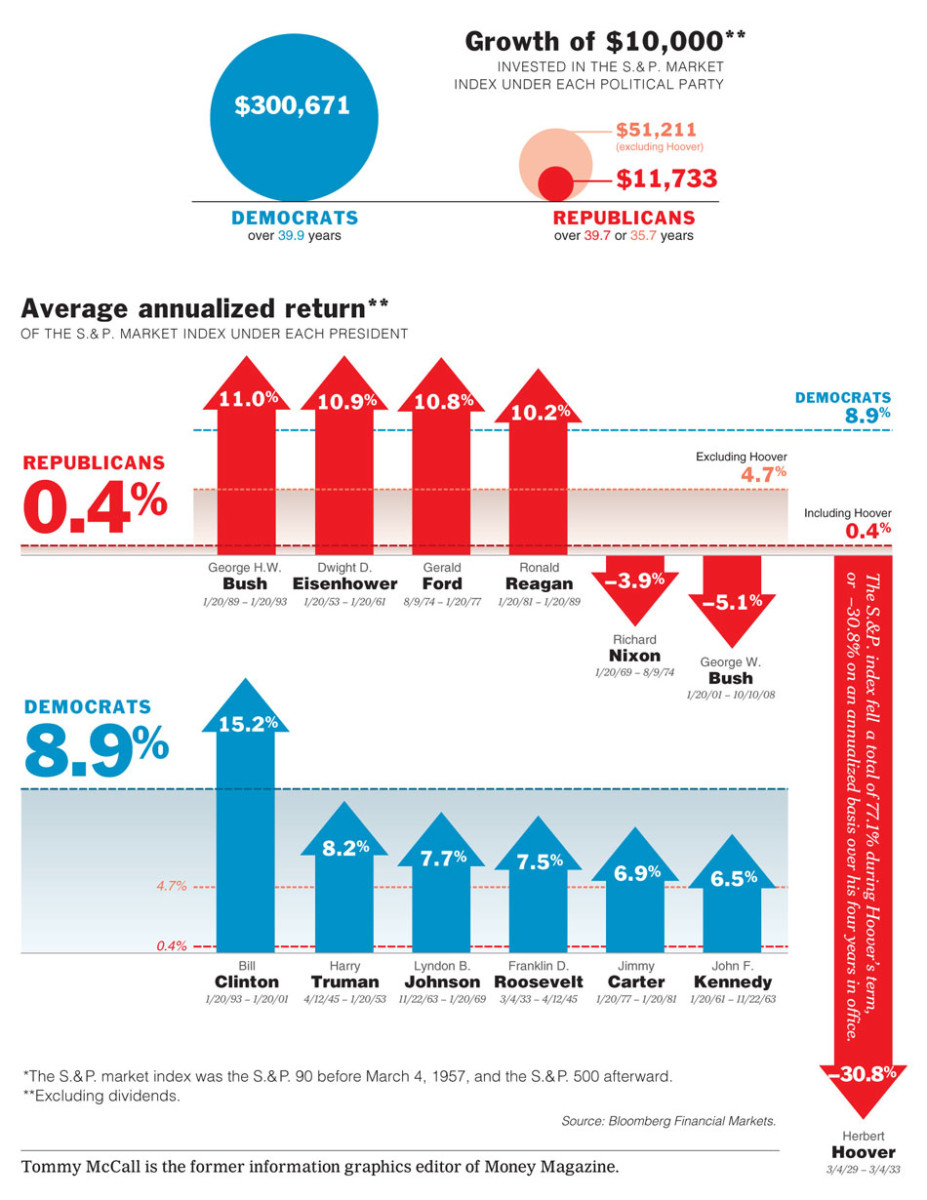More people have forwarded me the below graphic than any news item in recent memory. That’s kind of interesting, because I don’t find it a compelling or remotely persuasive argument. Perhaps my critique of Charlie Gasparino’s Obama Panic article led some people to think I was choosing sides. (I guess I was — I chose logical analysis over partisanship).
Here’s the issue:
“Since 1929, Republicans and Democrats have each controlled the
presidency for nearly 40 years. So which party has been better for
American pocketbooks and capitalism as a whole? Well, here’s an
experiment: imagine that during these years you had to invest
exclusively under either Democratic or Republican administrations. How
would you have fared?As of Friday, a $10,000 investment in the S.& P. stock market
index* would have grown to $11,733 if invested under Republican
presidents only, although that would be $51,211 if we exclude Herbert
Hoover’s presidency during the Great Depression. Invested under
Democratic presidents only, $10,000 would have grown to $300,671 at a
compound rate of 8.9 percent over nearly 40 years.”
That seems like a compelling argument. Except that off the top of my head, I can spot a dozen significant logic errors. Let’s take a closer look at a few:
First off, we are looking at 13 Presidents — 6 Democrats, and 7 Republicans. That is simply too small a sample size to draw a valid conclusion. Mark your calendars to defrost yourselves around November 4, 2804, when we have a larger sample size to play with.
Second, this takes a very complex system consisting of markets, economics and politics, plus their interaction, and reduces them all to a single variable: President’s party. As we have discussed in the past, that is an error. Controlling for a single variable when dealing with complex systems rarely yields insightful data.
Third, this looks to me like yet another case of *confusing correlation with causation. Simply because a given party is in office does not mean it is causing the markets to perform better or worse. To prove that was the case, you would need to show a causative link — that one party did x, y and z, while the other did a, b, and c — and that led to an X% outperformance. I have yet to see that proof offered by anyone.
The mere fact that one party is in the White House doesn’t mean all that much to the markets.
Finally, let’s take a snarky look at the past few Presidents, and see if we can’t figure out the secret to their performance numbers. My best guess is good (or bad) timing:
Bush II: Came into office after 18 year bull market and crash; Arrived after major deregulation (Glass Steagel, Commodities Futures Modernization act) were already fait accomplis, contributing mightily to the credit crisis
Clinton: Arrived post recession, mid 82-00 bull market. Greenspan Put came about in 1997. Got out before most of the wreckage took place.
Bush I: Bad timing everywhere: Recession was ending during re-election campaign, but not yet felt by election data yet. Mistimed the war, patriotic fervor was cooling before re-election.
Reagan: Came into office at the tail end of a 16 year Bear market.
Carter: Arrived post Vietnam, Post Watergate. Malaise. Inflation, oil crisis were rampant.
That smells too much like dumb luck to me.
>
UPDATE: October 16, 2008 9:18pm
Greg Mankiw addresses the same issue from a different perspective, and reaches the same conclusion.
Hey Prof — please tell me you aren’t still drinking that efficient market hypothesis Kool-Aid, are you? (You seem like an otherwise intelligent fellow!)
>
_________
* Correlation and Causation Let’s more precisely define our terms: Correlation is the occurence of two (or more) elements, usually in the same time, location or event. They may be independent (or not), they might be coincidental (or not). Correlated items can have no relationship other than their simultaneous occurence. Causation, on the other hand, refers to a specific relationship — one of authorship and creation. X caused Y to occur is a relationship of causality.
>
Previously:
Single vs. Multiple Variable Analysis in Market Forecasts (May 04, 2005)
http://bigpicture.typepad.com/comments/2005/05/single_vs_multi.html
What Investors Need to Know About Historical Data (02/01/08)
http://www.thestreet.com/s/what-investors-need-to-know-about-historical-data/university/apprenticed/10401545.html
Confusing Cause & Effect: Elections and Markets (January 09, 2008)
http://bigpicture.typepad.com/comments/2008/01/confusing-cause.html
>
chart via NYT



What's been said:
Discussions found on the web: